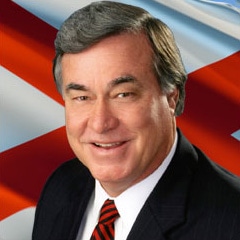One of the most profound stories which unfolded from the results of the November national election was the pick up of four seats in the United States Senate for the Republicans. Currently the makeup is 51 Republicans, 48 Democrats, and one Independent who votes with the Democrats. This razor thin margin basically reflects the close ideological divide in the country. It is a formula for legislative gridlock. However, when the new Senate convenes in January, the margin will have some cushion – it will be 55 Republicans and 45 Democrats.
The reason for the Republican increase can be found in the South. There were four changeovers from Democrat to Republican in Dixie. If you were to count Florida as a Southern state there were five. Starting in North Carolina, John Edwards had to make a choice to run for his Senate seat or to run for Vice President. He chose the latter. Most experts predicted that it was an easy decision, he probably would not have won reelection to a second term as North Carolina’s Senator. His voting record was more liberal than the state and he rarely came home to campaign. He barely won his first race for the seat six years ago, and probably only because he spent $7 million of his own money. His seat was taken by a conservative Republican, Richard Burr. In South Carolina, extreme conservative Congressman Jim DeMent defeated Democrat Inez Tenebaum for the seat of retiring Ernest “Fritz” Hollings. Hollings, a Democrat, had represented South Carolina in the Senate for close to 40 years. Georgia’s open seat went to Republican Johnny Isakson in a landslide. This was the seat held by Zell Miller, a conervative Democrat, who chose not to run again. The biggest victory in the South may have occurred in Louisiana. As you would expect, Louisiana has an unusual election system. They have an open primary where everybody runs regardless of party, and if someone gets over 50 percent they win. It usually requires a special election runoff in December. However, the Republican vote was so strong in Louisiana that Republican David Vitter got 51 percent against four credible Democratic candidates to win the seat outright. He becomes the first Republican Senator from Louisiana in over a century when he takes the seat of moderate Democrat John Breaux in January.
This Republican sweep of the Southern Senate seats can be attributed to the deep Southern landslide for George Bush. The coattails were long and unmistakable. The GOP strengthened its grip on the South. Forty years ago every Senate seat in the South was held by a conservative Democrat. In January, the entire Southern Senate delegation will be Republican. The states of Virginia, North Carolina, South Carooina, Georgia, Alabama, Mississippi, Tennessee, and Kentucky have Republicans in both of their seats.
In addition to the four-for-four pickup of open seats in the South, Florida also was a Republican pickup. The biggest Republican prize, nationwide, was the defeat of Democratic Senate Leader, Tom Daschle, in South Dakota. There were two Democratic gains in Illinois and Colorado which offset the six Republican victories. The four seat increase definitely tightens the Republican grip on the Senate.
The U.S. House will also remain in Republican control. The increase in the Congress makes it 231 Republicans and 200 Democrats. There was a marginal increase in the House, mostly in Texas where there had been some controversial, midterm redistributing which flipped five seats from Democrat to Republican.
However, very few seats ever change hands in the U.S. House. The seats are drawn to help the party that owns the seat keep it. The power of incumbency makes the seat impregnable to a challenger. In the last decade, all House incumbents have been reelected by more than 90 percent. In the last four years, 99 percent of all incumbent Congressmen who ran for reelection won. Even though they technically run every two years, they really don’t have to run.
Therefore, the 30-35 seat cushion the Republicans enjoy in the House will probably remain through 2010. That’s the next redistricting cycle after the next census is taken.
What exactly does this Republican majority mean as far as public policy decisions? I will delve into that next week.

Steve Flowers
Alabama’s premier columnist and commentator, Steve has analyzed Alabama politics for national television audiences on CBS, PBS, ABC and the British Broadcasting Network. Steve has been an up close participant and observer of the Alabama political scene for more than 50 years and is generally considered the ultimate authority on Alabama politics and Alabama political history.